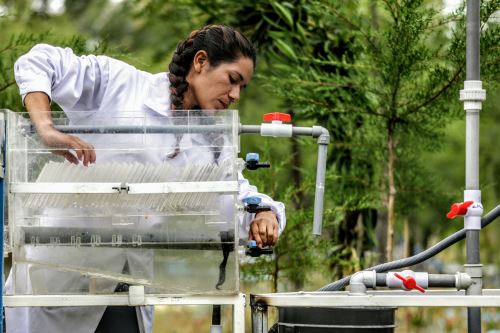On 18 October, Andina, the official press agency of the Peruvian government, published an article by Luis Iparraguirre about Nazia Loayza, a student involved in PEER and International Water Security Network (IWSN) projects as part of the Agua-Andes team. Nazia comes from a very poor area of Ayacucho, where coca production is high and drugs cartels are very active. She is in the process of finishing her thesis and completing her engineering degree. Nazia’s story has been picked up by several major newspapers in Peru, including El Comercio, La Republica, and Publimetro. Below is an abridged English translation of the original article.
***

Chemical engineer Nazia Loayza grew up in a Vraem village in the district of Santa Rosa, Ayacucho where she drank chocolate-coloured water, and where people bathe and end up dirtier.
Nazia promised she would study chemical engineering, and has developed her water research studies thanks to the support of USAID and the Centro de Competencias del Agua (CCA). With the help of her tutor, Professor Cipriano Mendoza of the Universidad Nacional de San Cristóbal de Huamanga (UNSCH), Loayza designed and built a prototype water treatment plant, which lowers the levels of turbidity, even for acid waters produced by mining, which have a large amount of arsenic, mercury and other heavy metals that are potentially harmful to the environment. It has been designed so that it can be imitated in other remote locations.
“We must remember that human beings are passengers in this world, so whatever we do must be friendly to the environment. My team will also improve the quality of life of the population, since it can reduce the rate of malnutrition and reduce the frequency of waterborne diseases, such as typhoid and gastritis,” Nazia says.
A recent report by the Intergovernmental Panel on Climate Change (IPCC) revealed the urgent need to implement immediate changes to limit global warming to 1.5°C instead of 2°C, as recommended in the Paris Agreement. This report also warns that the deadline will be 2030, since the consequences will be catastrophic and irreversible by then.
Bram Willems, President of CCA, explains: “The Centro de Competencias del Agua has the Agua-Andes program, whose objective is to understand the elements that guarantee water security from the peaks to the lower valleys. In this quest to develop knowledge, technology and solutions, we work on training talented people through research processes aimed at providing solutions to problems related to water management.” CCA runs an MBA program in Water Management, in partnership with the Universidad Peruana Cayetano Heredia.
CCA subsidizes the research studies of undergraduate and graduate students, thanks to the funding it receives from a network of universities in Belgium, from USAID, the Lloyd’s Register Foundation-funded International Water Security Network, and the invaluable help of the UNSCH.
Along with Nazia, there are other students who are working to benefit populations that lack safe drinking water.
“I have to thank all the people who worked with me and who did not discriminate against my potential because I am a woman. They taught me what is taught to any student in the electromechanical workshop, such as the mold on the wheel, cut wires and cans, and treated me like a student without thinking at any time that a woman could not do it. Remember that a woman recently won the Nobel Prize for Physics for the first time. Therefore, I tell girls to study, since nobody can limit them.”
As her filmed interview with Andina finished, and the microphones were removed, Nazia recalled how many times she had to get the mud out of her black hair after each shower. “If I do not find help to create a treatment plant that works for the entire district of Santa Rosa, at least I will do it for my mother,” she promises.
